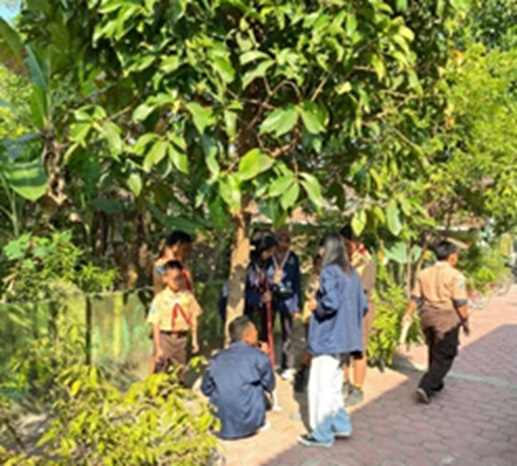Pembuatan Biopori sebagai Resapan di SDN II Cangkring, Krembung, Sidoarjo Making Biopores as Absorption at SDN II Cangkring, Krembung, Sidoarjo
Main Article Content
Abstract
Cangkring Village, Krembung, Sidoarjo, is one of the villages that is always affected by floods when the rainy season comes. One method that can be applied to reduce flooding is through biopores. The purpose of making Biopori Holes is to reduce the occurrence of waterlogging in an area and reduce the volume of organic waste that can be used as organic fertilizer. Biopori Infiltration Hole is a water infiltration facility used to overcome flooding by accelerating water absorption into the ground. Increasing the ability of the soil to absorb water can minimize the chance of surface runoff and reduce the potential for flooding. Biopori can also reduce the volume of organic waste that needs to be appropriately managed. Based on the problems in Cangkring Village, the team carried out service through socialization and training in making biopores. The target of this activity is students of grade IV and V SDN II Cangkring, Krembung, Sidoarjo. This activity aims to train students to know how to overcome waterlogging and use organic waste as fertilizer so that students care more about the surrounding environmental conditions.
Downloads
Article Details

This work is licensed under a Creative Commons Attribution-ShareAlike 4.0 International License.
Authors who publish with this journal agree to the following terms:
- Any article on the copyright is retained by the author(s).
- Author grant the journal, right of first publication with the work simultaneously licensed under a Creative Commons Attribution License that allows others to share work with acknowledgment of the work authors and initial publications in this journal.
- Authors are able to enter into a separate, additional contractual arrangements for non-exclusive distribution of published articles of work (eg, post-institutional repository) or publish it in a book, with acknowledgment of its initial publication in this journal.
- Authors are permitted and encouraged to post their work online (e.g., in institutional repositories or on their websites) prior to and during the submission process, as can lead to productive exchanges, as well as earlier and greater citation of published work.
- The article and any associated published material is distributed under the Creative Commons Attribution-ShareAlike 4.0 International License
References
Bayata, A. (2019). Review on Nutrional Value of Cassava for Use as a Staple Food. Science Journal of Analytical Chemistry, 7(4), 83-91. https://doi.org/10.11648/j.sjac.20190704.12
Dinata, P., Citriadin, Y., & Badrun. (2023). Pendidikan Kewirausahaan Dalam Meningkatkan Life Skill Santri Di Pondok Pesantren Al-Karimiyyah Bodak Barat Lombok Tengah. Manazhim : Jurnal Manajemen dan Ilmu Pendidikan, 5(2), 790-816. https://doi.org/10.36088/manazhim.v5i2.3487
Ginting, E., Utomo, J. S., Yulifianti, R., & Jusuf, M. (2011). Potensi Ubijalar Ungu sebagai Pangan Fungsional. Iptek Tanaman Pangan, 6(1), 116-138.
Hassan, Z. H. (2014). Aneka Tepung Berbasis Bahan Baku Lokal Sebagai Sumber Pangan Fungsional Dalam Upaya Meningkatkan Nilai Tambah Produk Pangan Lokal. Pangan, 23(1), 93-107. https://doi.org/10.33964/jp.v23i1.54
Husna, N. E., Novita, M., & Rohaya, S. (2013). Kandungan Antosianin dan Aktivitas Antioksidan Ubi Jalar Ungu Segar Dan Produk Olahannya. Agritech, 33(3), 296-302. https://doi.org/10.22146/agritech.9551
Indriani, F. (2012). Studi mengenai orientasi inovasi, pengembangan produk dan efektifitas promosi sebagai sebuah strategi untuk meningkatkan kinerja produk. Jurnal Studi Manajemen Organisasi, 3(2), 82-92. https://doi.org/10.14710/jsmo.v3i2.4191
Nurmala, Sinarti, T., Lilianti, E., Jusmany, Emilda, Arifin, A., et al. (2022). Usaha Kuliner sebagai Penggerak UMKM pada Masa Pandemi Covid-19. AKM: Aksi Kepada Masyarakat, 3(1), 65-74. https://doi.org/10.36908/akm.v3i1.458
Rizkhy, P. P., Widianingsih, I., & Pancasilawan, R. (2022). Adaptasi Program Ketahananan Pangan Terhadap Pandemi Covid-19 Di Kota Bandung. JANE (Jurnal Administrasi Negara), 13(2), 195-201. https://doi.org/10.24198/jane.v13i2.37996
Rosidah. (2014). Potensi Ubi Jalar Sebagai Bahan Baku Industri Pangan. TEKNOBUGA: Jurnal Teknologi Busana dan Boga, 1(1), 44-52. https://doi.org/10.15294/teknobuga.v1i1.6403
Sayekti, W. D. (2020). Determinant Factor Of Local Food Consumption Of The Households In Lampung Province. Pangan, 29(2), 127-140. https://doi.org/10.33964/jp.v29i2.469
Sekretariat Kabinet Republik Indonesia. (2021). Hasil Sensus Penduduk 2020; BPS: Meski Lambat, Ada Pergeseran Penduduk Antarpulau. https://setkab.go.id/hasil-sensus-penduduk-2020-bps-meski-lambat-ada-pergeseran-penduduk-antarpulau/
Sianturi, J. F. (2021). Budidaya Tanaman Ubi Jalar dalam Meningkat-kan Ketahanan Pangan Di Desa Banko Lestari Kabupaten Rokan Hilir. Journal Of Community Services Public Affairs (JCSPA), 1(3), 81-86.
Sidiq, F.F., Coles, D., Hubbard, C., Clark, B., & Frewer, L.J. (2021). Sago and the indigenous peoples of Papua, Indonesia: A review. Journal of Agriculture and Applied Biology, 2(2), 138-149. https://doi.org/10.11594/jaab.02.02.08
Tuhuteru, S., Kaiwai, O., Douw, L., Wilil, F., Agapa, I., Kogoya, et al. (2022). Pemberdayaan Masyarakat Kampung Kama Distrik Wesaput dalam Memaksimalkan Singkong dan Ubi Jalar sebagai Solusi Ketahanan Pangan di Masa Pandemik. Jurnal Abdimas Indonesia, 2(1):94-105. https://doi.org/10.53769/jai.v2i1.189
Zelin, O. & Setyawan, H. B. (2019). Pengaruh Macam Bahan Tanam Terhadap Pertumbuhan dan Hasil Tiga Varietas Talas (Colocasia esculenta L.). Berkala Ilmiah Pertanian, 2(3), 122-126. https://doi.org/10.19184/bip.v2i3.16286
